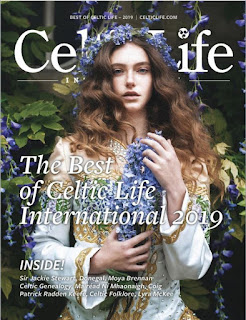Wonderful to see this excerpt from Flight of the Highlanders turn up in The Best of Celtic Life 2019. The 100-page magazine features an array of articles on everything from Celtic Folklore to Celtic Genealogy and Celebrating Celtic Culture.
FLIGHT OF THE HIGHLANDERS
Chapter 3: The Old Way of Life
In the Celtic tradition, “Thin Places” are sites where the natural and spiritual worlds meet and intermingle, separated by the merest veil. The ancient Celts would visit these sacred sites, among them Stonehenge in England and the Ring of Brodgar in Orkney, to experience the presence of their gods. For avowedly secular types, the concept works better historically. I think of the reconstructed Gaelic village in the Highland Folk Museum 45 miles south of Inverness, where you can wander in and out of blackhouses and see people at work in the clothing and spirit of another time. The same goes for Auchindrain Township, six miles south of Inverary. It is the only stone-built settlement to survive essentially unaltered from among hundreds that existed before the Highland Clearances. And what of the Gearrannan Blackhouse Village at a beautiful waterside location on the Isle of Lewis?
All three of those sites provide a sense of how most Highlanders lived in the decades before and after the mid-1700s, when the Battle of Culloden marked the beginning of the end for the Old Order. Political and military historians of the Middle Ages focus on kings and aristocrats and the battles they fought, won, or lost. But most Highlanders were farmers who stayed home in small townships made up of extended families.
They lived in “blackhouses,’ so-designated because they were dark, windowless, and blackened by peat-fire smoke. The term distinguishes them from the “white houses” which came later and introduced such amenities as windows and toilets. In Thatched Houses, author Colin Sinclair identifies three types of blackhouses according to their roof styles. The Hebridean has four walls of the same height and a ledge running around the edge of the roof. The Skye has four similar walls but no ledge: the thatch runs over the edge. And the Dailriadic has a Skye-style roof but pointed walls at two opposite ends providing for a pitched roof.
The common features among these three types tell us more about how people lived. Besides their thatched roofs and walls made of stone or peat slabs, blackhouses were usually oblong and divided into three compartments. You would enter the house through a flimsy door that opens into the byre or cow-house that forms one of the two end compartments. You would see two small black cows reclining on a bed of straw. But the place stinks of cow dung and chicken droppings so why tarry? You turn right and, through an opening or pass door, step through an internal wall into the main apartment. The third compartment is straight ahead, divided from this room by a wooden partition containing another pass door covered with a blanket.
You can’t help but notice the smoke, which gets thicker higher up, and you crouch to avoid the worst of it. The smoke curls upwards from a peat fire which sits on a stone slab in the middle of this dirt-floor apartment. It drifts eventually through a hole in the thatch located off-centre so that heavy rains do not douse the flames. A three-legged iron pot hangs over the fire from a chain attached to a beam in the roof. You sit down on a bench that occupies a side wall and notice a dresser neatly displaying rows of plates. Beneath it sits a washtub and beside it a wooden bucket.
Welcome to the house of the Gael in the Old Highlands. It allows for conversation and conviviality around the glowing peat fire, but mainly it provides shelter from the storm – though the roof of the blackhouse is not water tight. In rainy weather, heavy drops of inky black water make their way through the thatch. This happens often enough that people have a name for those falling droplets: snighe.
When weather permits, not surprisingly, the common folk spend most of their time outdoors. They tend their crops and their cattle. When James Boswell passed this way with Dr. Samuel Johnson in 1773, he wrote, “we had not rooms that we could command, for the good people here had no notion that a man could have any occasion but a mere sleeping place.”
(To read the rest of this excerpt, pick up the new "Best Of" issue of Celtic Life International. Better still, pick up the book, Flight of the Highlanders: The Making of Canada, now available everywhere in better bookstores.)








